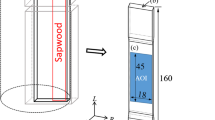Abstract
Ten plain-sawn boards of Scots pine (Pinus sylvestris L.) were compressed semi-isostatically according to the CaLignum process in a Quintus press at 25°C and 140 MPa. X-ray computerised tomography images of the same cross-sections were captured before and after compression and compared using a transformation algorithm. In the algorithm the shape of compressed cross-sections were converted to the same shape as non-compressed using the density variation between pixels. Density after compression and the increase in density were analysed using PLS regression. The regressor variables described position in the cross-section and wood properties of each pixel. Heartwood and other resinous wood were less compressed than sapwood, particularly in boards with high resin content. Density also increased little close to the press table, especially in whorls with large knots. Higher original density gives lower degree of compression but still higher density after compression.
Zusammenfassung
Zehn plangesägte Kiefernbretter (P. sylvestris L.) wurden semi-isostatisch nach dem CaLignum-Prozess in einer Quintus-Presse bei 25°C und 140 Mpa verdichtet. Röntgen-CT-Bilder identischer Querschnitte wurden vor und nach Verdichtung aufgenommen und mit Hilfe eines Transformier-Algorithmus verglichen. Die Form des verdichteten Querschnitts wird dabei in das ursprüngliche Format des unverdichteten Querschnitts umgewandelt, wofür die Dichtevariation zwischen den Pixeln herangezogen wird. Die Dichte nach Kompression und der Dichteanstieg wurden mittels PSL-Regression analysiert. Die Regressions-Variablen beschreiben Position und Eigenschaften jedes einzelnen Pixels. Kernholz und anderes harzhaltiges Holz wuden weniger verdichtet als Splintholz, insbesondere bei Brettern mit hohem Harzgehalt. Die Dichte stieg in der Nähe des Presstisches nur geringfügig an, vor allem im Bereich von Astquirlen mit hohem Astanteil. Bei höherer Ausgangsdichte ergab sich nach der Kompression ein geringerer Verdichtungsgrad, wenn auch bei höherer Enddichte.



Similar content being viewed by others
References
Ando K, Onda H (1999) Mechanism for deformation of wood as a honeycomb structure I: effect of anatomy on the initial deformation process during radial compression. J Wood Sci 45:120–126
Back EL, Allen LH (2000) Pitch control, wood resin and deresination. Tappi, Atlanta, p 392
Beall FC (2000) Subsurface sensing of properties and effects in wood and wood products. Subsurf Sens Technol Appl 1:181–203
Beall FC (2002) Overview of the use of ultrasonic technologies in research on wood properties. Wood Sci Technol 36:197–212. DOI: 10.1007/s00226-002-0138-4
Berndt H, Schniewind AP, Johnson GC (1999) High-resolution ultrsonic imaging of wood. Wood Sci Technol 33:185–198
Blomberg J, Persson B (2004) Plastic deformation in small clear pieces of Scots pine (Pinus sylvestris L.) during densification with the CaLignum process. J Wood Sci 50(4): 307–314
Choi D, Thorpe JL, Hanna RB (1991) Image analysis to measure strain in wood and paper. Wood Sci Technol 25:251–262
Danvind J, Synnergren P (2001) Method for measuring shrinkage behaviour of drying wood using digital speckle photography and X-ray computerised tomography. Proceedings of seventh international IUFRO wood-drying conference, Tsukuba, Japan, pp 276–281
Dinwoodie JM, Desch HE (1996) Timber: structure, properties, conversion and use, 7th edn. Macmillan, London
Farruggia F, Perré P (2000) Microscopic tensile test in the transverse plane of earlywood and latewood parts of spruce. Wood Sci Technol 34:65–82
Geladi P, Kowalski BR (1986) Partial least-squares regression: a tutorial. Anal Chim Acta 185:1–17
Johannisson TG (1994) High pressure forming of body parts using flexible tools. Sheet Metal Ind 71:20–22
Johansson J (2001) Property predictions of wood using microwaves. Licentiate Thesis, Luleå University of Technology
Kollman FFP, Côté WA (1984) Principles of wood science and technology, vol I. Springer, Berlin Heidelberg, New York
Kuo M-L, Arganbright DG (1980) Cellular distribution of extractives in redwood and incense cedar. part ii. microscopic observation of the location of cell wall and cell cavity extractives. Holzforschung 34:41–47
Lindgren O (1992) Medical CT-scanners for non-destructive wood density and moisture content measurements. Doctoral Thesis, Luleå University of Technology
Skötte A (1976) Quintus sheet-metal forming presses - a new means for metal forming with high pressures and single tools. Sheet Metal Ind 53:212, 215–216, 219–220
Trenard Y (1977) Study of the isostatic compressibility of some timbers. Holzforschung 31:166–171
Wangaard FF (1950) The mechanical properties of wood. Wiley, New York, p 377
Wold S, Esbensen K, Geladi P (1987) Principal Component Analysis. Chemom Intell Lab Syst 2:37–52
Zink AG, Davidson RW, Hanna RB (1995) Strain measurement in wood using a digital image correlation technique. Wood Fiber Sci 27:346–359
Author information
Authors and Affiliations
Corresponding author
Rights and permissions
About this article
Cite this article
Blomberg, J., Persson, B. An algorithm for comparing density in CT-images taken before and after compression of Pinus sylvestris. Holz Roh Werkst 63, 23–29 (2005). https://doi.org/10.1007/s00107-004-0544-4
Published:
Issue Date:
DOI: https://doi.org/10.1007/s00107-004-0544-4




